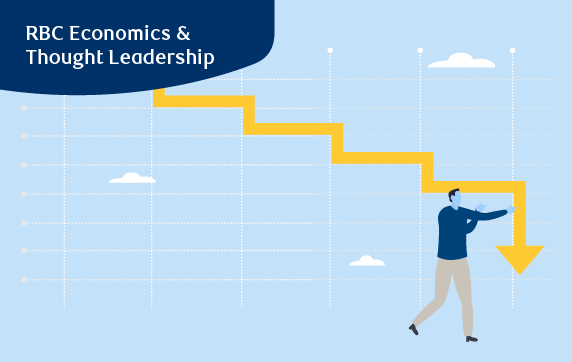Highlights:
- Bank of Canada and ECB both kickstarted the easing cycles in June but neither is expected to race rates to the bottom.
- In Canada, lagging economic conditions and below target inflation readings suggest a relatively steeper path lower for BoC policy rates. We think that means 100 bps cuts this year, followed by another 100 bps in 2025 that will leave the overnight rate back at a ‘neutral’ 3%.
- The ECB also lowered interest rate in June while the BoE is expected to follow with a first cut in August. In both regions however, firmer labour markets and higher services inflation argue for a slow rate cutting path.
- With both the economy and inflation stuck in medium-high gear, the Federal Reserve is expected to be among the last to cut rates. Moving forward, strong demand for services is still expected to cool, driving inflation readings sustainably lower before prompting the Fed to cut interest rates in December.
June saw both the BoC and the ECB start normalizing monetary policy from very restrictive levels and cut key interest rates by 25 bps. The decisions marked a start of central bank divergence – we look for the BOE to follow with a first rate cut in August and the Fed to stay on hold until later in December, and the RBA not following with a first rate cut until 2025.
In Canada, the pivot to interest rate cuts was a straightforward decision for the BoC – the economy has been underperforming global peers (on a per-capita basis) for over a year. The unemployment has been rising, and inflation growth has already slowed back to within the BoC’s 1% to 3% target range. Economic data in other regions has been more mixed, although has also softened enough in the euro area and the U.K. to prompt cut rates from the central banks this summer.
For those that have already started to move rates lower (the BoC and ECB cuts followed earlier decreases by the SNB and Riksbank), focus has now shifted to how fast and how far interest rates will fall – our own base case assumption is the pace of interest rate reductions will be ‘gradual’ in all regions but slightly larger and faster in Canada given the underperforming economy that’s not surprising given a higher, and faster-rising debt service ratio among private non-financial sector. Overall, we look for 200 basis points of interest rate cuts from the BoC by the end of 2025 (100 bps in this year and next) versus 100 basis points cuts from the ECB and the BOE.
For the U.S. Fed, the timing of the first interest rate cut remains an open question. As true as ever, the decision will be contingent on domestic inflation trends and labour market data – both have shown small improvements in early summer. May’s downside surprise in core U.S. services inflation readings was a welcome reprieve after consecutive strong readings earlier this year and has tilted market expectations towards a September interest rate cut. But one data point doesn’t make a trend, and while there are early signs that economic growth is slowing (and the unemployment rate is drifting higher), we continue to think the inflation reacceleration scare earlier this year will be enough to keep the Fed from cutting rates until later in December.
Central bank bias
Central Bank
Current Policy Rate
(Latest Move)
Next move
 BoC
BoC
4.75%
-25 bps in Jun/24
-25 bps
Jul/24
 Fed
Fed
5.25-5.5%
+0 bps in Jun/24
0 bps
Jul/24
 BoE
BoE
5.25%
+0 bps in Mar/24
0 bps
Jun/24
 ECB
ECB
3.75%
-25 bps in Jun/24
0 bps
Jul/24
 RBA
RBA
4.35%
+0 bps in May/24
0 bps
Jun/24
Catch up in wage growth shouldn’t worry central banks, yet
Currently elevated wage growth is proving a common grievance among most central banks, although a lot of it still reflects a catching up to past high inflation. Real wage growth since pre-pandemic 2019 is still falling short of the average run rate in all regions we cover. And interest rates, despite starting to move lower, will stay in “restrictive” territory for some time. That should broadly continue to limit demand for goods and services, cooling labour market conditions while easing nominal wage growth. Indeed, most forward-looking survey data have been pointing to further unwinding in wage pressures in the year ahead.
Concerns about elevated wage growth are ultimately really centred around their potential spillover to higher inflation. On that front, what really matters is wage growth relative to productivity (output per hour worked) growth. In the U.S., strong productivity growth (about 8% since 2019) makes it much less likely that currently elevated wage growth will feed into higher inflation pressures in the future.
Canada’s productivity underperformance, rooted in structural factors outside the current economic cycle, make labour costs look higher by comparison. Historically however, real wage growth in Canada have generally been moving in sync with gains in productivity. And as broader labour demand backdrop continues to soften, it should again be more of a reason for wage growth to drift lower, rather than for inflation to drift higher.
Rate cuts won’t spur economic growth right away
Remaining debate ahead of the BoC rate cut last week was more about when (June or July) not if a rate cut was appropriate. The broader economic growth, labour market, and inflation backdrop was enough evidence for the central bank to start easing the monetary policy. The deterioration in Canada’s economy, although relatively gradual compared to sharp contractions in the past has still been substantial on a cumulative basis. Per-capita GDP was 3% below pre-pandemic levels in Q1 2024 and essentially unchanged from a decade ago.
That is not to say that the BoC will rush to lower interest rates to provide stimulus. The central bank is clearly still concerned about inflation risks and had in the announcement in June highlighted the same pressures points, including global oil prices (although those have declined more than 10% since April), domestic housing demand (still soft but could reaccelerate as interest rates fall) and wage growth (elevated but expected to moderate as hiring demand slows) as key areas to follow.
We expect overnight rate cuts from the Bank of Canada at a pace of 25 basis points per meeting until December. The pace may be faster than other central banks but can still be counted as gradual, relative to both the 2022/23 hiking cycle and cutting cycles from BoC in the past. That pace of rate reductions also means that interest rates will still be above ‘neutral’ rates by end of this year. Down to the household level, those that are facing mortgage renewals will for a while continue to face higher debt servicing costs relative to their income. That should keep domestic demand under pressure in the near-term – we don’t expect a meaningful return to higher per-capita real GDP or improvement in labour markets until 2025.
U.S. inflation slowed in May but not yet ‘stable’
Trends in U.S. inflation data were broadly encouraging post spring – the Fed’s preferred ‘supercore’ CPI measure that counts price growth for services prices outside of energy and shelter declined outright in May for the first time since September 2021. That marked a welcome change following worrying signs of acceleration earlier this year. But price growth is still running above the Fed’s 2% inflation objective – and the Fed’s mandate on inflation doesn’t stop at ‘low’, it also extends to price stability. On that front, progress is still lacking.
Indeed, the start and stop in price growth year-to-date has pushed the 6-month standard deviation in ‘supercore’ CPI higher back to late 2021 levels. Fed Chair Powell was clear in hist post-FOMC press conference that the Fed needs to see more of the softer inflation growth like the one in May, to obtain the confidence that inflation pressures are drifting sustainably lower towards target.
He did however again highlighted progress with balancing demand and supply in the labour market and judged that “conditions in the labour market have returned to about where they stood on the eve of the pandemic, relatively tight but not overheated.” Part of that resilience could be traced back to risk-on sentiment that has led to narrower credit spreads and gains in the equity markets since last fall. Net interest payments made by non-financial corporations in the U.S. meantime have continued to plunge, with businesses having taken advantage of lower borrowing rates during the pandemic through refinancing their debt. All these factors probably cushioned what would’ve been a worse deterioration in labour market conditions in the U.S. to-date.
ECB and BoE to deliver shallow easing
In both the Euro Area and the U.K., economic conditions started out this year on a stronger footing than expected, recovering from a relatively weak backdrop after a recession over the second half of 2023. GDP growth surprised to the upside in Q1, and early survey data are pointing to sustained momentum in Q2 supported by ongoing recovery in manufacturing activities, all while services activities remain robust.
A faster expected comeback in the economic conditions is good news unless it upsets the BoE’s and ECB’s projections that inflation will continue to ease. Already in both regions, domestic services inflation prints have remained stickier than central banks would like. Moving forward we can count more tailwinds to both growth and inflation, including robust domestic demand back by rising real wage growth, on top of expected rate cuts. It is against that backdrop that we expect a higher level of restraint from the central banks in the easing portion of the cycle, and that both the ECB and the BoE will proceed at a slower once every quarter cutting pace that leave key interest rates lower by 100 bps in total by mid-2025.
See previous editions of Financial Markets Monthly.

Download the Report
This article is intended as general information only and is not to be relied upon as constituting legal, financial or other professional advice. The reader is solely liable for any use of the information contained in this document and Royal Bank of Canada (“RBC”) nor any of its affiliates nor any of their respective directors, officers, employees or agents shall be held responsible for any direct or indirect damages arising from the use of this document by the reader. A professional advisor should be consulted regarding your specific situation. Information presented is believed to be factual and up-to-date but we do not guarantee its accuracy and it should not be regarded as a complete analysis of the subjects discussed. All expressions of opinion reflect the judgment of the authors as of the date of publication and are subject to change. No endorsement of any third parties or their advice, opinions, information, products or services is expressly given or implied by Royal Bank of Canada or any of its affiliates.
This document may contain forward-looking statements within the meaning of certain securities laws, which are subject to RBC’s caution regarding forward-looking statements. ESG (including climate) metrics, data and other information contained on this website are or may be based on assumptions, estimates and judgements. For cautionary statements relating to the information on this website, refer to the “Caution regarding forward-looking statements” and the “Important notice regarding this document” sections in our latest climate report or sustainability report, available at: https://www.rbc.com/our-impact/sustainability-reporting/index.html. Except as required by law, none of RBC nor any of its affiliates undertake to update any information in this document.


